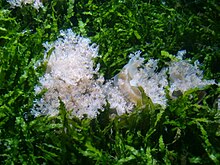| Revision as of 15:29, 17 March 2019 editLoopy30 (talk | contribs)Autopatrolled, Event coordinators, Extended confirmed users, Page movers, Pending changes reviewers102,527 edits Undid revision 884117501 by 128.231.234.3 (talk) rvt change to WP:ENGVARTag: Undo← Previous edit | Revision as of 23:29, 22 April 2019 edit undoPBZE (talk | contribs)Extended confirmed users2,265 editsmNo edit summaryTags: Mobile edit Mobile app edit iOS app editNext edit → | ||
| Line 26: | Line 26: | ||
| * '']'' | * '']'' | ||
| == Defence |
== Defence system == | ||
| ''Cassiopea'' species have a mild sting since they are primarily ], but sensitive individuals may have a stronger reaction. The photosynthesis occurs because, like most ]s, they host ] in their tissues.<ref>{{cite book |last=Murphy |first=Richard C. |title=Coral Reefs: Cities Under The Sea |year=2002 |publisher=The Darwin Press |location=Princeton, New Jersey |ISBN=978-0-87850-138-0 | ref=harv}}</ref> The stinging cells are excreted in a mucus; swimming over the jellyfish (especially using swim fins) may cause transparent, essentially invisible, sheets of this mucus to be lifted up into the water column, where they are then encountered by unsuspecting swimmers.{{Citation needed|date=February 2017}} The stings, appearing in the form of a red rash-like skin irritation, are known for being extraordinarily itchy. Sometimes this jellyfish is picked up by the ] '']'' and carried on its back. The crab uses the jellyfish to defend itself against possible predators. | ''Cassiopea'' species have a mild sting since they are primarily ], but sensitive individuals may have a stronger reaction. The photosynthesis occurs because, like most ]s, they host ] in their tissues.<ref>{{cite book |last=Murphy |first=Richard C. |title=Coral Reefs: Cities Under The Sea |year=2002 |publisher=The Darwin Press |location=Princeton, New Jersey |ISBN=978-0-87850-138-0 | ref=harv}}</ref> The stinging cells are excreted in a mucus; swimming over the jellyfish (especially using swim fins) may cause transparent, essentially invisible, sheets of this mucus to be lifted up into the water column, where they are then encountered by unsuspecting swimmers.{{Citation needed|date=February 2017}} The stings, appearing in the form of a red rash-like skin irritation, are known for being extraordinarily itchy. Sometimes this jellyfish is picked up by the ] '']'' and carried on its back. The crab uses the jellyfish to defend itself against possible predators. | ||
Revision as of 23:29, 22 April 2019
Not to be confused with Cassiopeia (disambiguation).
| Cassiopea | |
|---|---|

| |
| Cassiopea sp. | |
| Scientific classification | |
| Domain: | Eukaryota |
| Kingdom: | Animalia |
| Phylum: | Cnidaria |
| Class: | Scyphozoa |
| Order: | Rhizostomeae |
| Family: | Cassiopeidae Agassiz, 1862 |
| Genus: | Cassiopea Péron & Lesueur, 1809 |
| Species | |
|
8 species, see text | |

Cassiopea (upside-down jellyfish) is a genus of true jellyfish and the only members of the family Cassiopeidae. They are found in warmer coastal regions around the world, including shallow mangrove swamps, mudflats, canals, and turtle grass flats in Florida, and the Caribbean and Micronesia. The medusa usually lives upside-down on the bottom, which has earned them the common name. These jellyfish partake in a symbiotic relationship with photosynthetic dinoflagellates and therefore, must lay upside-down in areas with sufficient light penetration to fuel their energy source. Where found, there may be numerous individuals with varying shades of white, blue, green and brown.
Species
According to the World Register of Marine Species, this genus includes 8 species:
- Cassiopea andromeda
- Cassiopea depressa
- Cassiopea frondosa
- Cassiopea medusa
- Cassiopea mertensi
- Cassiopea ndrosia
- Cassiopea ornata
- Cassiopea xamachana
Defence system
Cassiopea species have a mild sting since they are primarily photosynthetic, but sensitive individuals may have a stronger reaction. The photosynthesis occurs because, like most corals, they host zooxanthellae in their tissues. The stinging cells are excreted in a mucus; swimming over the jellyfish (especially using swim fins) may cause transparent, essentially invisible, sheets of this mucus to be lifted up into the water column, where they are then encountered by unsuspecting swimmers. The stings, appearing in the form of a red rash-like skin irritation, are known for being extraordinarily itchy. Sometimes this jellyfish is picked up by the crab Dorippe frascone and carried on its back. The crab uses the jellyfish to defend itself against possible predators.
Behavior
Certain species of Cassiopea have been observed to enter a sleep state, indicated by a decreased pulsation rate.
References
- "Cassiopeidae". WoRMS. World Register of Marine Species. Retrieved 3 August 2012.
- Ohdera Aki H., Abrams Michael J., Ames Cheryl L., Baker David M., Suescún-Bolívar Luis P., Collins Allen G., Freeman Christopher J., Gamero-Mora Edgar, Goulet Tamar L., Hofmann Dietrich K., Jaimes-Becerra Adrian, Long Paul F., Marques Antonio C., Miller Laura A., Mydlarz Laura D., Morandini Andre C., Newkirk Casandra R., Putri Sastia P., Samson Julia E., Stampar Sérgio N., Steinworth Bailey, Templeman Michelle, Thomé Patricia E., Vlok Marli, Woodley Cheryl M., Wong Jane C.Y., Martindale Mark Q., Fitt William K., Medina Mónica (2018). "Upside-Down but Headed in the Right Direction: Review of the Highly Versatile Cassiopea xamachana System". Frontiers in Ecology and Evolution. 6: 35. doi:10.3389/fevo.2018.00035.
{{cite journal}}: CS1 maint: multiple names: authors list (link) CS1 maint: unflagged free DOI (link) - "Cassiopea". WoRMS. World Register of Marine Species. Retrieved 3 August 2012.
- Murphy, Richard C. (2002). Coral Reefs: Cities Under The Sea. Princeton, New Jersey: The Darwin Press. ISBN 978-0-87850-138-0.
{{cite book}}: Invalid|ref=harv(help) - "The surprising, ancient behavior of jellyfish". EurekAlert. Retrieved 22 September 2017.
External links
- Photo of a Crab carrying an Upside Down Jellyfish (Cassiopea andromeda)
- Bernice Pauahi Bishop Museum entry on Cassiopea andromeda
- A Symbiotic Lifestyle: C. xamachana and Zooxanthellae
| Taxon identifiers | |
|---|---|
| Cassiopea | |